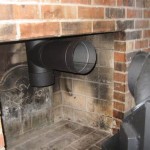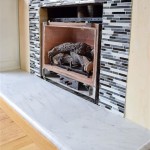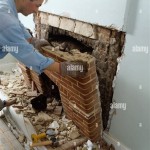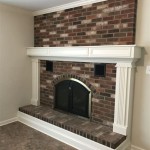What Kind of Paint to Use to Whitewash a Brick Fireplace
Whitewashing a brick fireplace offers a way to refresh its appearance, creating a lighter, more modern aesthetic while retaining the brick's natural texture. The process involves applying a diluted paint mixture to the brick surface, allowing the brick's inherent character to show through. Selecting the appropriate type of paint is crucial for achieving the desired look, ensuring proper adhesion, and promoting the longevity of the finish. Incorrect paint choices can lead to peeling, discoloration, or an undesirable, opaque appearance.
The term “whitewash” itself is historically associated with a mixture of lime and water used to create a protective and brightening coating. While traditional lime whitewash provides a distinct, breathable finish, modern paint options offer improved durability and ease of application for interior applications. This article explores the various paint types suitable for whitewashing a brick fireplace, examining their properties, application techniques, and potential advantages and disadvantages.
Understanding Brick Porosity and Its Impact on Paint Selection
Brick is a porous material, meaning it contains numerous tiny pores and channels. This porosity significantly influences the way paint adheres and interacts with the surface. When paint is applied to brick, it is absorbed into these pores. This absorption aids in adhesion, but it also means that brick can absorb a substantial amount of paint. Therefore, the paint selected must be compatible with the porous nature of brick to ensure a durable and aesthetically pleasing result.
Paints that are overly thick or have a high solids content may not penetrate the brick sufficiently, leading to poor adhesion and a higher risk of peeling or chipping. Conversely, paints that are too thin may be absorbed excessively, requiring multiple coats to achieve adequate coverage and potentially leading to an uneven finish. Priming the brick before painting can help to mitigate these issues by creating a more uniform surface for the paint to adhere to. However, the choice of primer is also critical and should be compatible with both the brick and the intended paint.
Before starting any whitewashing project, it is also highly advisable to thoroughly clean the brick surface. This removes any dirt, dust, soot, or other contaminants that may hinder paint adhesion. A wire brush and a suitable cleaning solution can be used to scrub the brick, followed by thorough rinsing with clean water. Allow the brick to dry completely before proceeding with the painting process.
Latex Paint: A Popular Choice for Whitewashing
Latex paint is a water-based paint that is widely used for interior painting projects due to its ease of application, relatively low odor, and quick drying time. It is also breathable, allowing moisture to escape from the brick, which helps to prevent blistering and peeling. Several types of latex paint are well-suited for whitewashing brick fireplaces, depending on the desired level of opacity and the specific characteristics of the brick.
Flat or matte latex paint is a good option for achieving a more subtle, understated whitewashed look. Its non-reflective finish helps to conceal imperfections in the brick surface and creates a soft, diffused appearance. Eggshell or satin latex paint offers a slightly more durable and washable finish, while still maintaining a relatively low sheen. These sheens are helpful when dealing with a fireplace that may require occasional cleaning.
When using latex paint for whitewashing, it is essential to dilute it with water to achieve the desired transparency. The ratio of paint to water can vary depending on the desired effect, but a common starting point is a 1:1 ratio. Experimenting with different ratios on a small, inconspicuous area of the fireplace is recommended to determine the optimal dilution for the specific brick type and personal preference.
Applying latex paint for whitewashing typically involves using a brush or roller to apply the diluted paint mixture to the brick surface. A brush allows for more precise application, particularly in crevices and corners, while a roller can cover larger areas more quickly. After applying the paint, immediately wipe it off with a clean cloth or sponge to remove excess paint and allow the brick's texture to show through. The amount of paint removed will determine the final degree of whitewashing. Multiple thin coats may be necessary to achieve the desired effect.
Acrylic Paint: Enhanced Durability and Adhesion
Acrylic paint is another water-based paint option that offers enhanced durability and adhesion compared to latex paint. It is more resistant to moisture, stains, and fading, making it a good choice for fireplaces that are frequently used or exposed to high levels of heat. Acrylic paint also tends to form a more flexible film than latex paint, which can help to prevent cracking and peeling over time.
Like latex paint, acrylic paint can be diluted with water to achieve the desired transparency for whitewashing. The same principles of dilution ratios and application techniques apply. However, acrylic paint may dry slightly faster than latex paint, so it is important to work quickly and efficiently to avoid unevenness or streaking. The faster drying time can be advantageous in some cases, allowing for quicker completion of the project.
For whitewashing a brick fireplace, exterior acrylic latex paint can be used. Exterior paints are formulated to withstand harsh weather conditions and are more durable than interior paints. The use of exterior acrylic latex paint is recommended for fireplaces that are exposed to moisture. If the fireplace is in an area prone to dampness, exterior acrylic latex paint provides an additional layer of protection.
Before applying acrylic paint, ensuring the brick surface is properly prepared is even more critical than with latex paint. Thorough cleaning and priming are essential to ensure optimal adhesion and prevent future problems. A high-quality acrylic primer specifically designed for masonry surfaces should be used to seal the brick and provide a uniform base for the paint.
Choosing the appropriate sheen for acrylic paint is also important. Matte or eggshell finishes are generally preferred for whitewashing, as they provide a softer, more natural look. However, satin or semi-gloss finishes can be used in areas that require more frequent cleaning or are subject to higher levels of wear and tear.
Milk Paint: A Traditional and Natural Option
Milk paint is a traditional type of paint made from milk protein (casein), lime, pigment, and water. It is a natural, non-toxic option that provides a unique, chalky finish. Milk paint is known for its excellent adhesion to porous surfaces like brick and its ability to create a rustic, aged look. It is breathable, allowing moisture to escape from the brick, and it does not contain any volatile organic compounds (VOCs).
Milk paint comes in powder form and must be mixed with water before use. The mixing process is relatively simple, but it is important to follow the manufacturer's instructions carefully to ensure proper consistency and adhesion. Because milk paint has a short pot life, it should be mixed in small batches and used within a few hours.
Applying milk paint to brick requires a slightly different technique than applying latex or acrylic paint. Milk paint is typically applied in thin, even coats using a brush or sponge. It may require multiple coats to achieve the desired level of coverage and opacity. After the paint has dried, it can be sealed with a clear topcoat to protect the finish and enhance its durability.
One of the unique characteristics of milk paint is its ability to chip or flake over time, creating a naturally aged appearance. This can be desirable for some homeowners who are looking for a more rustic or vintage look. However, if a more uniform and durable finish is desired, it is important to properly prepare the brick surface before painting and to apply a sealant after painting.
Milk paint is also available in a wide range of colors, although it is often chosen for its natural, earthy tones. It can be tinted with pigments to create custom colors, but it is important to use pigments that are compatible with milk paint. Experimentation on a small area is always recommended before applying milk paint to the entire fireplace.
While milk paint offers a unique aesthetic and environmental benefits, it is important to note that it may not be as durable or washable as latex or acrylic paint. It may also require more maintenance over time to prevent chipping or flaking. However, for homeowners who are looking for a natural, non-toxic option with a rustic look, milk paint can be an excellent choice.

How To Whitewash A Brick Fireplace What Know 2024

Whitewash Your Brick Fireplace With Limewash Paint Romabio

How To Whitewash A Brick Wall Or Fireplace Young House Love

How To Whitewash A Brick Fireplace What Know 2024

How To Whitewash A Brick Fireplace What Know 2024

How To Whitewash A Brick Fireplace What Know 2024

Ten Things To Know Before You Whitewash Your Brick Re Invintage Home

How To Whitewash A Brick Fireplace What Know 2024

Whitewashed Brick Fireplace Update Our Tiny Nest

4 Great Paint Makeovers Marlton Distinctive Interior Designs
Related Posts








